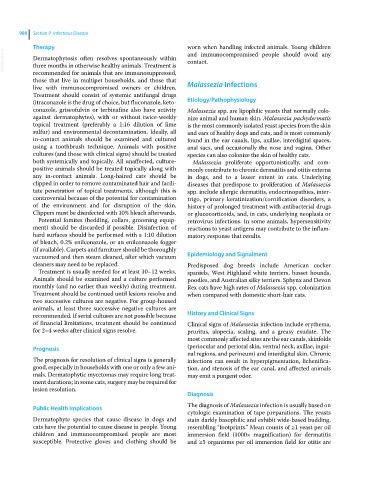Page 1050 - Clinical Small Animal Internal Medicine
P. 1050
988 Section 9 Infectious Disease
Therapy worn when handling infected animals. Young children
VetBooks.ir Dermatophytosis often resolves spontaneously within and immunocompromised people should avoid any
contact.
three months in otherwise healthy animals. Treatment is
recommended for animals that are immunosuppressed,
those that live in multipet households, and those that
live with immunocompromised owners or children. Malassezia Infections
Treatment should consist of systemic antifungal drugs
(itraconazole is the drug of choice, but fluconazole, keto Etiology/Pathophysiology
conazole, griseofulvin or terbinafine also have activity Malassezia spp. are lipophilic yeasts that normally colo
against dermatophytes), with or without twice‐weekly nize animal and human skin. Malassezia pachydermatis
topical treatment (preferably a 1:16 dilution of lime is the most commonly isolated yeast species from the skin
sulfur) and environmental decontamination. Ideally, all and ears of healthy dogs and cats, and is most commonly
in‐contact animals should be examined and cultured found in the ear canals, lips, axillae, interdigital spaces,
using a toothbrush technique. Animals with positive anal sacs, and occasionally the nose and vagina. Other
cultures (and those with clinical signs) should be treated species can also colonize the skin of healthy cats.
both systemically and topically. All unaffected, culture‐ Malassezia proliferate opportunistically, and com
positive animals should be treated topically along with monly contribute to chronic dermatitis and otitis externa
any in‐contact animals. Long‐haired cats should be in dogs, and to a lesser extent in cats. Underlying
clipped in order to remove contaminated hair and facili diseases that predispose to proliferation of Malassezia
tate penetration of topical treatments, although this is spp. include allergic dermatitis, endocrinopathies, inter
controversial because of the potential for contamination trigo, primary keratinization/cornification disorders, a
of the environment and for disruption of the skin. history of prolonged treatment with antibacterial drugs
Clippers must be disinfected with 10% bleach afterwards. or glucocorticoids, and, in cats, underlying neoplasia or
Potential fomites (bedding, collars, grooming equip retrovirus infections. In some animals, hypersensitivity
ment) should be discarded if possible. Disinfection of reactions to yeast antigens may contribute to the inflam
hard surfaces should be performed with a 1:10 dilution matory response that results.
of bleach, 0.2% enilconazole, or an enilconazole fogger
(if available). Carpets and furniture should be thoroughly
vacuumed and then steam cleaned, after which vacuum Epidemiology and Signalment
cleaners may need to be replaced. Predisposed dog breeds include American cocker
Treatment is usually needed for at least 10–12 weeks. spaniels, West Highland white terriers, basset hounds,
Animals should be examined and a culture performed poodles, and Australian silky terriers. Sphynx and Devon
monthly (and no earlier than weekly) during treatment. Rex cats have high rates of Malassezia spp. colonization
Treatment should be continued until lesions resolve and when compared with domestic short‐hair cats.
two successive cultures are negative. For group‐housed
animals, at least three successive negative cultures are
recommended. If serial cultures are not possible because History and Clinical Signs
of financial limitations, treatment should be continued Clinical signs of Malassezia infection include erythema,
for 2–4 weeks after clinical signs resolve. pruritus, alopecia, scaling, and a greasy exudate. The
most commonly affected sites are the ear canals, skinfolds
Prognosis (periocular and perioral skin, ventral neck, axillae, ingui
nal regions, and perineum) and interdigital skin. Chronic
The prognosis for resolution of clinical signs is generally infections can result in hyperpigmentation, lichenifica
good, especially in households with one or only a few ani tion, and stenosis of the ear canal, and affected animals
mals. Dermatophytic mycetomas may require long treat may emit a pungent odor.
ment durations; in some cats, surgery may be required for
lesion resolution.
Diagnosis
Public Health Implications The diagnosis of Malassezia infection is usually based on
cytologic examination of tape preparations. The yeasts
Dermatophyte species that cause disease in dogs and stain darkly basophilic and exhibit wide‐based budding,
cats have the potential to cause disease in people. Young resembling “footprints.” Mean counts of ≥1 yeast per oil
children and immunocompromised people are most immersion field (1000× magnification) for dermatitis
susceptible. Protective gloves and clothing should be and ≥5 organisms per oil immersion field for otitis are

